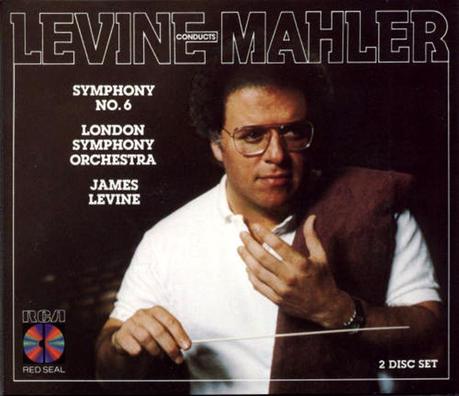
Original jacket art for James Levine's recording of Mahler's Sixth
with the London Symphony Orchestra. © 1980 RCA Red Seal/Sony Classics
These recordings preserve James Levine as the young firebrand, putting an energetic, deeply personal stamp on these great works. He conducts the London Symphony Orchestra in the First with youthful vitality--you literally hear the players come to life and celebrate the arrival of Spring. The funeral march is phrased with child-like wonder (appropriate, since it's based on Frere Jacques) and the weighty finale is both muscular and bold.
Those words could also apply to the Chicago Symphony Orchestra's performance of the massive first movement of the Third, with its granite-like opening theme. The massive march (the first movement alone is 30 minutes) is played with swaggering drive of the mighty Chicago brass section who delve into each repetition with enthusiasm. The later movements expand into cosmic regions, climaxing in the final Adagio. The Fourth features sharp playing in the first two movements, and a long (22 minutes) lingering performance of the famous slow movement.
The instrumental trilogy of Mahler's middle period (Nos. 5, 6 and 7) is the core this set. The Fifth surges from its funereal opening to a triumphant close. The Adagietto is played with grace and charm by the famed Philadelphia strings. The fatalistic death-march of the Sixth is taken at a decidedly unsafe speed by the LSO. The hammer-blows of the final movement send the entire piece careening into darkness. The Seventh breathes with appropriate mystery and awe, and the "night mission" of the central three movements sounds like the score of a particularly good Hollywood thriller, with the Chicago forces in top form.
Leading the Philadelphia Orchestra once more, James Levine gives the Ninth a spectacular reading that penetrates to the center of this profound work without giving way to schmaltz or sentimentality. The 30-minute opening movement is perfectly balanced a great song of sorrow that shifts from plucked, faltering strings to sobbing, raging brass. The later movements receive a spectacular performance, from the complex contrapuntal Rondo-Burleske to the finale, which resonates with peace and acceptance even as it fades to silence.
The set concludes with the Tenth, presented here in its completion by musicologist Deryck Cooke. (This was the Philadelphians' second recording of the symphony.) James Levine shows good command over the work's cinematic five-movement structure, generating intensity in the "funeral drum" scene and the central Purgatorio movement. Unfortunately, this Tenth marks the conclusion of the set. Since the conductor changed labels in the 1980s and focused his career on the Met, the Second and Eighth were not recorded.

